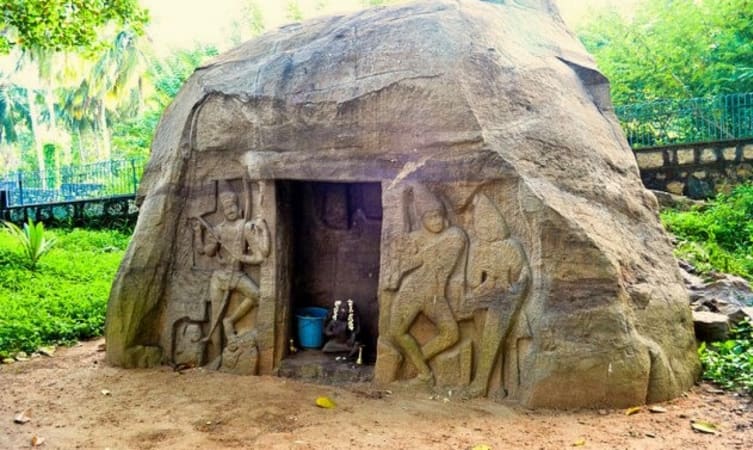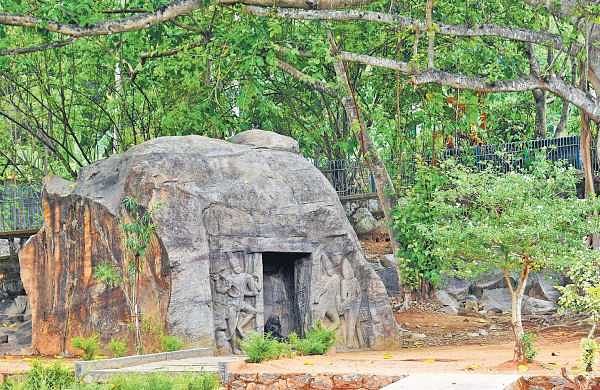Vizhinjam RockCut Cave(വിഴിഞ്ഞം ഗുഹാക്ഷേത്രം)
 Vizhinjam Rock Cut Cave Temple is one of Trivandrum’s most popular tourist attractions, located 17 kilometers from the city. The god of Vinandhara Dakshinamurthi is housed in this single-celled rock-cut sculpture from the eighth century.
Vizhinjam Rock Cut Cave Temple is one of Trivandrum’s most popular tourist attractions, located 17 kilometers from the city. The god of Vinandhara Dakshinamurthi is housed in this single-celled rock-cut sculpture from the eighth century.
Temples have always been a significant component of Indian culture, and this particular temple is particularly regarded in South India. The shrine’s an outside wall is adorned with images of Lord Shiva and Goddess Parvati. There is also an unfinished Lord Shiva sculpture depicting him dancing and carrying a bow. The wall’s beautiful sculptures are well worth admiring.
The Bhagavathy Temple is another important temple close to the Vizhinjam Rock Cut Cave Temple. This sacred shrine dates from the ninth to tenth centuries AD. A Marine Aquarium, which houses unique marine ornamental fish, is also nearby.
Considered to be the smallest rock-cut shrine in southern India, the Vizhinjam Rock-cut cave is dated to back to 8th century. The shrine has a central cell with an independent sculpture of Dakshinamurthy and on either side of the cell are unfinished sculptures of Siva and Parvathi. It is believed to be one of the earliest rock-cut cave temples in Kerala. This rock cut cave is now a protected monument under the control of the Archaeological Survey of India since 1965.
The Vizhinjam Rock-cut Cave is the smallest rock-cut shrine in southern India, dating back to the 8th century. The shrine contains a central cell with an autonomous sculpture of Dakshinamurthy, and unfinished Siva and Parvathi statues on either side of the cell. It is thought to be one of Kerala’s first rock-cut cave temples. Since 1965, the Archaeological Survey of India has been in charge of this rock-cut cave, which is now a protected monument.
Temple Timings: 09:00 – 18:00 hrs. It remains closed on Mondays.
A small, 8th century rock cut temple, Vizhinjam Rock Cut Caves may not be grand enough, but patrons of ancient Indian architecture may appreciate the one-celled shrine with a loose sculpture of Vinandhara Dakshinamurthi in this granite sculpture. Located about 17 kilometres from the city of Thiruananthapuram, the cave remained nondescript for many years. It features Tripurantaka (Shiva) carrying a bow and arrow in two of his four hands and HIS divine consort Parvati. Visit it only if you have a serious thing for ancient temple architecture.
The one-celled shrine with a loose sculpture of Vinandhara Dakshinamurthi in this granite sculpture may not be grand enough for patrons of ancient Indian architecture, but patrons of ancient Indian architecture may appreciate the one-celled shrine with a loose sculpture of Vinandhara Dakshinamurthi in this granite sculpture. For many years, the cave, which is around 17 kilometers from Thiruvananthapuram, remained unremarkable. Tripurantaka (Shiva) is depicted with a bow and arrow in two of his four hands, as well as HIS heavenly companion Parvati. Only go if you’re a serious fan of ancient temple architecture.
The rock-cut cave temple at Vizhinjam, believed to be one of the earliest rock-cut cave temples in India, is least familiar to Indians. But the temple is a paradise for the foreign tourists interested in archeology. “As many as 50 tourists visit the place during the tourist season and most of them are foreigners. The importance of the same is not known to the natives,” says Anilkumar M, monumental staff at the temple.
The temple contains rock-cut sculptures of the eighth century dedicated to Vinandhara Dakshinamurthi and the outer wall has sculptures of Lord Shiva and Goddess Parvathi. “The temple is believed to be built by ‘Ay dynasty’ for whom Vizhinjam was the administrative capital of the kingdom. The Ay dynasty is believed to have ruled over parts of southern India between the eighth and tenth centuries AD. The temple is considered to be the smallest rock-cut shrine in south India and is protected under the control of the Archaeological Survey of India since 1965,”